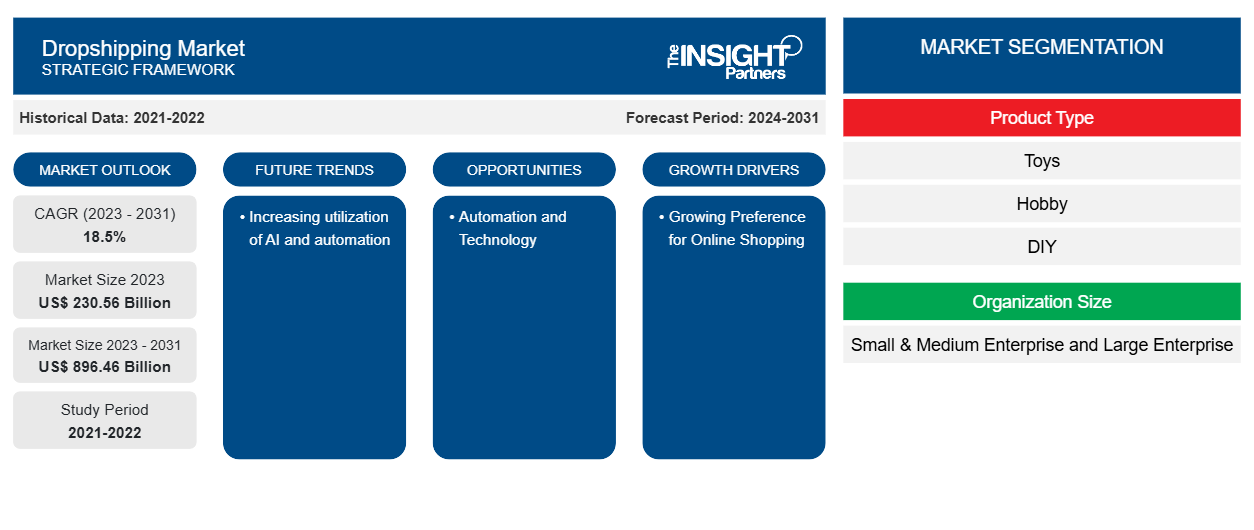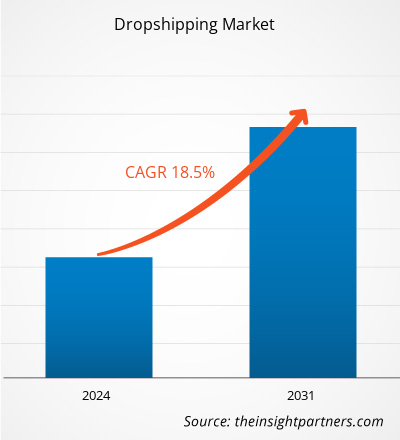Dropshipping Market Dynamics and Developments by 2031
Historic Data: 2021-2022 | Base Year: 2023 | Forecast Period: 2024-2031Dropshipping Market Size and Forecast (2021 - 2031), Global and Regional Share, Trend, and Growth Opportunity Analysis Report Coverage: By Product Type (Toys, Hobby, and DIY, Furniture and Appliances, Food and Personal Care, Electronics and Media, Fashion, and Others), Organization Size (Small & Medium Enterprise and Large Enterprise), and Geography
- Report Date : Mar 2026
- Report Code : TIPRE00011190
- Category : Technology, Media and Telecommunications
- Status : Data Released
- Available Report Formats :


- No. of Pages : 150
The global dropshipping market size is expected to grow from US$ 230.56 billion in 2023 to US$ 896.46 billion by 2031; it is anticipated to expand at a CAGR of 18.5% from 2023 to 2031. The increasing utilization of AI and automation is likely to remain a key dropshipping market trends.
Dropshipping Market Analysis
The burgeoning e-commerce sector has seen tremendous expansion in recent years, propelling the dropshipping business. The rise of the e-commerce industry has made it simpler for firms to establish online storefronts and access a worldwide client base, propelling the dropshipping market.
Dropshipping Market Overview
Dropshipping is a retail approach in which an online business does not hold its items in inventory. Instead, when a consumer places an order, the business sends it along with payment to a dropshipping provider. The supplier then sends the goods to the consumer. Many business owners choose dropshipping because it allows suppliers to handle order fulfillment. This implies that retailers do not need to invest in storage space or risk being trapped with unsold products. As a result, firms may devote more resources to other retail operations, including marketing.
Customize This Report To Suit Your Requirement
You will get customization on any report - free of charge - including parts of this report, or country-level analysis, Excel Data pack, as well as avail great offers and discounts for start-ups & universities
Dropshipping Market: Strategic Insights

-
Get Top Key Market Trends of this report.This FREE sample will include data analysis, ranging from market trends to estimates and forecasts.
Dropshipping Market Drivers and Opportunities
Growing Preference for Online Shopping to Favor Market
Ecommerce is transforming the retail landscape. People's purchasing habits are changing swiftly, and buying anything online is becoming the new standard. This expansion is being driven by a variety of causes, including the development of mobile commerce, the rise of social networking, and the growing popularity of subscription services. Countries in Asia-Pacific and South America are now experiencing the fastest development in the ecommerce sector. This is attributable to both the fast adaption of new technology and the demographic structure of these nations, which has more young people than senior individuals. These younger generations are more tech-savvy and prefer to shop online rather than offline.
Automation and Technology
Dropshipping is a business strategy in which the seller does not hold inventory in stock but instead sends customer orders and shipment data to the manufacturer, another merchant, or a wholesaler, who distributes the products straight to the client. Drop shippers benefit greatly from automation since it improves productivity and streamlines operations. Drop shippers may save time and minimize burden by automating many areas of their business, resulting in a more efficient and profitable operation. Dropshipping automation software helps dropshippers automate daily duties including order routing to manufacturers, inventory management, and shipment procedures.
Dropshipping Market Report Segmentation Analysis
Key segments that contributed to the derivation of the dropshipping market analysis product type, and organization size.
- Based on product type, the market is divided into smart toys, hobby and DIY, furniture and appliances, food and personal care, electronics and media, fashion, and others. The electronics and media segment held a larger market share in 2023.
- Based on organization size, the market is bifurcated into small & medium enterprise and large enterprise. The large enterprise segment held a larger market share in 2023.
Dropshipping Market Share Analysis by Geography
The geographic scope of the Dropshipping market report is mainly divided into five regions: North America, Asia Pacific, Europe, Middle East & Africa, and South America/South & Central America. North America dominated the dropshipping market in 2023. The rise in consumer disposable income is one of the factors driving the growth of the dropshipping market in North America. Dropshipping offers advantages such as fewer overhead costs and a broad product portfolio, which attract retailers and contribute to the growth of the market.
Dropshipping Market Regional Insights
The regional trends and factors influencing the Dropshipping Market throughout the forecast period have been thoroughly explained by the analysts at The Insight Partners. This section also discusses Dropshipping Market segments and geography across North America, Europe, Asia Pacific, Middle East and Africa, and South and Central America.
Dropshipping Market Report Scope
| Report Attribute | Details |
|---|---|
| Market size in 2023 | US$ 230.56 Billion |
| Market Size by 2031 | US$ 896.46 Billion |
| Global CAGR (2023 - 2031) | 18.5% |
| Historical Data | 2021-2022 |
| Forecast period | 2024-2031 |
| Segments Covered |
By Product Type
|
| Regions and Countries Covered |
North America
|
| Market leaders and key company profiles |
|
Dropshipping Market Players Density: Understanding Its Impact on Business Dynamics
The Dropshipping Market is growing rapidly, driven by increasing end-user demand due to factors such as evolving consumer preferences, technological advancements, and greater awareness of the product's benefits. As demand rises, businesses are expanding their offerings, innovating to meet consumer needs, and capitalizing on emerging trends, which further fuels market growth.

- Get the Dropshipping Market top key players overview
Dropshipping Market News and Recent Developments
The dropshipping market is evaluated by gathering qualitative and quantitative data post primary and secondary research, which includes important corporate publications, association data, and databases. The following is a list of developments in the market:
- In March 2023, ShipStation launched ShipStation Dropship Manager, a new solution designed specifically for dropship managers. This product aims to automate and streamline order fulfillment processes, reducing errors caused by manual vendor management. The core features of ShipStation Dropship Manager include order routing, real-time order status updates between dropship managers and vendors, branded tracking, and the ability to use a custom email domain for enhanced customer engagement. Additionally, dropship managers can invite their suppliers to join the platform, facilitating quick onboarding and entry into the market.
(Source: ShipStation, Press Release, 2023)
Dropshipping Market Report Coverage and Deliverables
The "Dropshipping Market Size and Forecast (2021–2031)" report provides a detailed analysis of the market covering below areas:
- Market size and forecast at global, regional, and country levels for all the key market segments covered under the scope
- Market dynamics such as drivers, restraints, and key opportunities
- Key future trends
- Detailed PEST/Porter's Five Forces and SWOT analysis
- Global and regional market analysis covering key market trends, major players, regulations, and recent market developments
- Industry landscape and competition analysis covering market concentration, heat map analysis, prominent players, and recent developments
- Detailed company profiles
Frequently Asked Questions
What are the driving factors impacting the global dropshipping market?
Which are the key players holding the major market share of the global dropshipping market?
What will be the market size of the global dropshipping market by 2031?
What is the estimated market size for the global dropshipping market in 2023?
What are the future trends of the global dropshipping market?
Ankita is a dynamic market research and consulting professional with over 8 years of experience across the technology, media, ICT, and electronics & semiconductor sectors. She has successfully led and delivered 100+ consulting and research assignments for global clients such as Microsoft, Oracle, NEC Corporation, SAP, KPMG, and Expeditors International. Her core competencies include market assessment, data analysis, forecasting, strategy formulation, competitive intelligence, and report writing.
Ankita is adept at handling complete project cycles—from pre-sales proposal design and client discussions to post-sales delivery of actionable insights. She is skilled in managing cross-functional teams, structuring complex research modules, and aligning solutions with client-specific business goals. Her excellent communication, leadership, and presentation abilities have enabled her to consistently deliver value-driven outcomes in fast-paced and evolving market environments.
- Historical Analysis (2 Years), Base Year, Forecast (7 Years) with CAGR
- PEST and SWOT Analysis
- Market Size Value / Volume - Global, Regional, Country
- Industry and Competitive Landscape
- Excel Dataset
Recent Reports
Testimonials
The Insight Partners' SCADA System Market report is comprehensive, with valuable insights on current trends and future forecasts. The team was highly professional, responsive, and supportive throughout. We are very satisfied and highly recommend their services.
RAN KEDEM Partner, Reali Technologies LTDsI requested a report on a very specific software market and the team produced the report in a few days. The information was very relevant and well presented. I then requested some changes and additions to the report. The team was again very responsive and I got the final report in less than a week.
JEAN-HERVE JENN Chairman, Future AnalyticaWe worked with The Insight Partners for an important market study and forecast. They gave us clear insights into opportunities and risks, which helped shape our plans. Their research was easy to use and based on solid data. It helped us make smart, confident decisions. We highly recommend them.
PIYUSH NAGPAL Sr. Vice President, High Beam GlobalThe Insight Partners delivered insightful, well-structured market research with strong domain expertise. Their team was professional and responsive throughout. The user-friendly website made accessing industry reports seamless. We highly recommend them for reliable, high-quality research services
YUKIHIKO ADACHI CEO, Deep Blue, LLC.This is the first time I have purchased a market report from The Insight Partners.While I was unsure at first, I visited their web site and felt more comfortable to take the risk and purchase a market report.I am completely satisfied with the quality of the report and customer service. I had several questions and comments with the initial report, but after a couple of dialogs over email with their analyst I believe I have a report that I can use as input to our strategic planning process.Thank you so much for taking the extra time and making this a positive experience.I will definitely recommend your service to others and you will be my first call when we need further market data.
JOHN SUZUKI President and Chief Executive Officer, Board Director, BK TechnologiesI wish to appreciate your support and the professionalism you displayed in the course of attending to my request for information regarding to infectious disease IVD market in Nigeria. I appreciate your patience, your guidance, and the fact that you were willing to offer a discount, which eventually made it possible for us to close a deal. I look forward to engaging The Insight Partners in the future, all thanks to the impression you have created in me as a result of this first encounter.
DR CHIJIOKE ONYIA MANAGING DIRECTOR, PineCrest Healthcare Ltd.Reason to Buy
- Informed Decision-Making
- Understanding Market Dynamics
- Competitive Analysis
- Identifying Emerging Markets
- Customer Insights
- Market Forecasts
- Risk Mitigation
- Boosting Operational Efficiency
- Strategic Planning
- Investment Justification
- Tracking Industry Innovations
- Aligning with Regulatory Trends




















 Get Free Sample For
Get Free Sample For